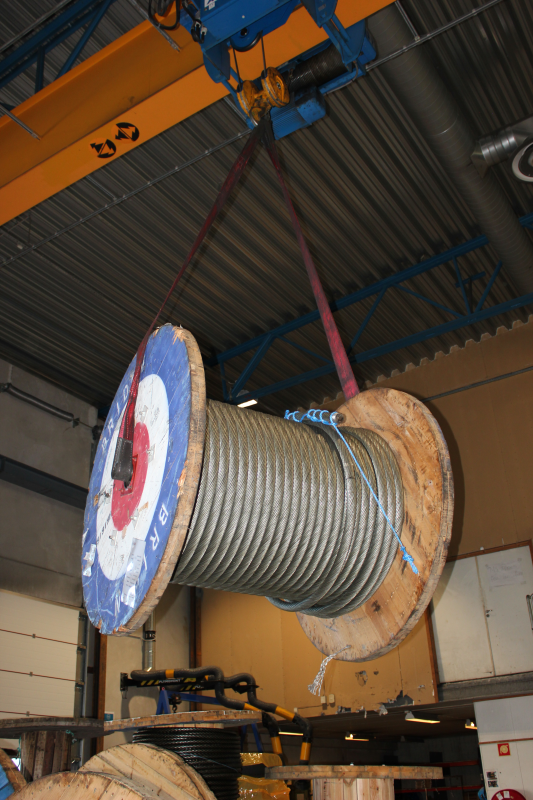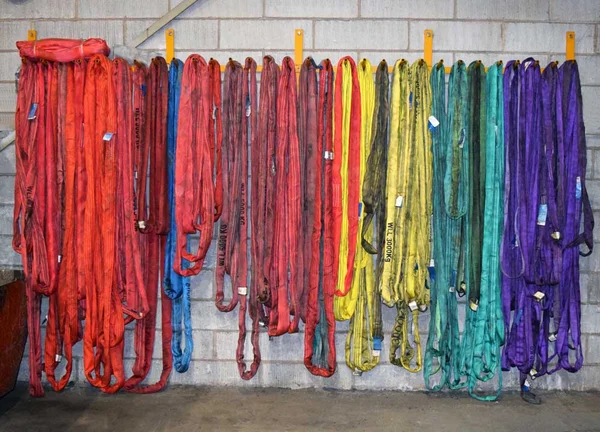Proper use of textile slings

Using textile slings in challenging environments or hazardous applications requires understanding their chemical resistance and handling procedures. The resistance to chemicals varies depending on the material of the slings.
Here is a summary of how different chemicals affect synthetic fibers:
- Polyester (PES) is resistant to most mineral acids but can be damaged by alkalis.
- Polyamides (PA) are virtually immune to alkalis but are attacked by mineral acids.
- Polypropylene (PP) is minimally affected by acids or alkalis and is suitable for applications requiring high chemical resistance, excluding solvents.
- Dyneema® offers excellent resistance against both acids and alkalis.
Warning: Solutions of acids or alkalis that are harmless can become concentrated through evaporation and cause damage. Contaminated slings should be removed from service immediately, soaked in cold water, dried naturally, and examined by a competent person. If in doubt, always contact CERTEX for more information.
Slings with Grade 8, 10 and 12 (80, 100, 120) fittings and multi-leg slings with Grade 8, 10 and 12 (80, 100,120) master links should not be used in acidic conditions due to the risk of hydrogen embrittlement. Consult CERTEX if exposure to chemicals is likely.
Temperature effects
Round- and webbing slings are suitable for use and storage within the following temperature ranges:
- Polyester and polyamide: -40°C to +100°C
- Polypropylene: -40°C to +80°C
- Dyneema®: -50°C to +70°C
At low temperatures, ice formation can occur if moisture is present, acting as a cutting agent and abrasive, causing internal damage to the sling. Ice also reduces the sling's flexibility, potentially rendering it unserviceable.
These temperature ranges may vary in chemical environments, consult CERTEX for advice. Limited indirect ambient heating is acceptable within these ranges for drying slings. Dyneema® does not absorb water, unlike polyester and polyamide.
Effects of ultraviolet radiation
Man-made fibers used in round slings are susceptible to degradation from ultraviolet radiation. round slings should not be stored in direct sunlight or near sources of ultraviolet radiation.
Before first use
Before using a sling for the first time, ensure:
- The sling matches the order specifications.
- The manufacturer's certificate is available.
- The identification and WLL marked on the sling match the certificate information.
- The sling has been properly maintained.
- The sling is suitable for the intended lifting task.

Safe use
Preparation
When selecting and specifying round slings and webbing slings, consider the required working load limit, mode of use and nature of the load. The size, shape, weight, intended method of use, working environment and load characteristics all affect the correct selection.
The chosen sling should be strong enough and of the correct length for the mode of use. If multiple slings are used to lift a load, they should be identical. The sling material should not be adversely affected by the environment or the load.
Consider ancillary fittings and lifting appliances that should be compatible with the sling(s). The design of the sling's end should also be considered, such as whether end fittings or soft eyes are suitable.
When using slings with soft eyes together with a hook/fitting, the smallest length should be at least 3.5 times the hook's/fitting's maximum thickness, and the angle formed in the eye should never exceed 20°.
When connecting a sling with a soft eye to a lifting device, the part of the device on which the sling's eye rests should be straight if the sling's bearing width is below 75 mm. In this case, the attachment to the lifting device should have a bend radius of at least 0.75 times the sling's bearing width. Wide slings can be affected by the hook's inner radius, preventing equivalent load distribution across the sling's full width.
Round slings/webbing slings should not be overloaded. Use the correct mode factor. Working load limits for some modes may be indicated on the label. For multi-leg slings, do not exceed the maximum angle to the vertical.
Protect slings from edges, friction, and wear, whether from the load or the lifting appliance. When reinforcements and protection against damage from corners and/or wear are part of the sling, they should be correctly positioned. Additional protection may be necessary.
Method of connection, basket hitch, choke hitch and symmetry
Method of connection
Follow good slinging practices:
- Plan the slinging
- Lifting and lowering operations before starting the lift.
Round slings/webbing slings should be correctly positioned and attached to the load safely. Slings should be placed on the load to adopt a flattened form, ensuring uniform loading across their width. They should never be knotted or twisted.
Stitches should never be positioned above hooks or other lifting appliances; they should always be on the standing part of the sling.
Prevent damage to labels by keeping them away from the load, hook and angle of choke.
Secure the load with the sling(s) to prevent it from toppling or falling out during the lift. Arrange the sling(s) so that the lifting point is directly above the center of gravity, ensuring the load is balanced and stable. Movement of the sling over the lifting point is possible if the load's center of gravity is not below the lifting point.
Basket hitch
When using a basket hitch, secure the load since there is no gripping action like with a choke hitch, and the sling can roll through the lifting point. For slings used in pairs, a spreader is recommended to ensure the sling legs hang as vertically as possible and the load is equally divided between the legs.
Choke hitch
When using a choke hitch, position the sling to allow the natural (120°) angle to form and avoid heat generation by friction. Never force a sling into position or attempt to tighten the bite. For greater security and to prevent the load from sliding through the sling, use a "double choke hitch."
Symmetry of loading
For multi-leg slings, WLL values are based on symmetrical loading of the sling assembly. This means that when lifting a load, the sling legs are symmetrically disposed in plan and subtended at the same angle to the vertical.
For 3-leg slings, if the legs are not symmetrically disposed in plan, the greatest tension is in the leg where the sum of the plan angles to the adjacent legs is greatest. The same effect occurs in 4-leg slings, but the rigidity of the load should also be considered. With a rigid load, most of the weight may be taken by only three or even two legs, with the remaining legs serving to balance the load.
Safety of lifting, landing the load and storage
Safety of lifting
Ensure the safety of personnel during the lift. Warn people in the danger area that the operation is about to take place and evacuate the immediate area if necessary.
- Keep hands and other body parts away from the sling to prevent injury as the slack is taken up.
- Perform a test lift by taking up the slack until the sling is taut. Raise the load slightly and check that it is secure and assumes the intended position. This is especially important with basket or other loose hitches where friction retains the load.
- If the load tends to tilt, lower it and reposition the attachments. Repeat the trial lift until the load's stability is ensured.
- During the lift, control the load to prevent accidental rotation or collision with other objects.
- Avoid snatch or shock loading, as this increases the forces acting on the sling.
- Do not drag the load or the sling over the ground or rough surfaces.
Landing the load
Lower the load in a controlled manner, just as when lifting. Avoid trapping the sling when lowering the load. Do not let the load rest on the sling if it could cause damage, and do not attempt to pull the sling from beneath the load when it is resting on it.
Storage of slings
After completing the lifting operation, return the sling to proper storage. Store slings in clean, dry, and well-ventilated conditions at ambient temperature, on a rack, away from heat sources, chemicals, fumes, corrodible surfaces, direct sunlight, or other sources of ultraviolet radiation.
Inspect slings for any damage before placing them in storage. Never return damaged slings to storage.
If lifting slings have come into contact with acids and/or alkalis, dilute with water or neutralize with suitable media before storage.
Depending on the sling material and chemicals, it may be necessary to request additional cleaning procedure recommendations from CERTEX after using the sling in the presence of chemicals.
Hang wet slings to dry naturally after use or cleaning.

Do you wish to know more? Please reach out.
For faster response, call us directly at +47 66 79 95 00!
Colour coding of textile slingsEver wondered why polyester slings come in different colors? This article explains the color coding system for textile slings. |
Learn more |
Criteria for rejecting textile slingsRound slings and webbing slings need regular inspections for defects and damage. But when is it time to discard them? |
Learn more |
Proper use of textile slingsHow should textile slings be utilized? Explore safe load handling techniques, coupling methods, proper storage, and safe lifting practices. |
Learn more |
Washing instructions of textile slingsIt might seem odd, but synthetic slings like round slings and webbing slings can be washed. Find out how here. |
Learn more |
What are the different types of textile slings?Lifting slings are available in various materials and strengths, so selecting the right sling for your specific lifting task is crucial. |
Learn more |
What is Dyneema®?What exactly is Dyneema®? Are all HMPE fibers identical? What makes HMPE unique? This article will provide answers to your questions. |
Learn more |


